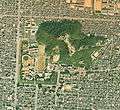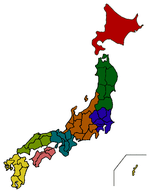Matsuyama Castle (Iyo)
Matsuyama Castle (松山城, Matsuyama-jō) is a flatland-mountain castle that was built in 1603 on Mount Katsuyama, whose height is 132 meters, in Matsuyama city in Ehime Prefecture (the former Iyo Province).
| Matsuyama Castle 松山城 | |
|---|---|
| Matsuyama, Ehime Prefecture, Japan | |
Matsuyama Castle Tower (tenshu)
%26groups%3D_59a5960a5571a3f58056dd6ae7918be04301f8fe.svg)
| |
| Type | Japanese castle |
| Site information | |
| Condition | Largely intact |
| Site history | |
| Built | 1603 |
| Built by | Kato Yoshiaki |
History
In 1583, Katō Yoshiaki was rewarded for his service as a retainer of Toyotomi Hideyoshi at the Battle of Shizugatake and was appointed lord of Masaki with an annual income of 60,000 Koku(石, Koku). After Hideyoshi's death, Katō joined into Tokugawa clan and fought against Toyotomi clan at the Battle of Sekigahara, whose income was 200,000 Koku.
Thanks to this income, in 1602, Katō Yoshiaki originally built Matsuyama castle on Katsuyama in Matsuyama.
In 1627, Katō Yoshiaki was transferred to the Aidzu clan before the completion of Matsuyama Castle. Gamō Tadatomo came to Iyo and completed ninomaru. in the same year. It had a large five-story tenshu, or castle keep, which was moved to Aizuwakamatsu Castle. Gamō Tadatomo died in Matsuyama in 1634 without heirs, shortly after completing the ninomaru, and his domains were forthwith confiscated and the major portion of them bestowed on a Tokugawa Fudai, which was a class of daimyō who were hereditary vassals of Tokugawa family before the Battle of Sekigahara.[1]
After Tadatomo, Matsudaira Sadayuki became the new lord. He completed a new castle keep in 1642, at which time the castle tower was rebuilt from five stories to three stories. His heirs continued to rule the castle after his death.
However, on New Year's Day, 1784, this keep was struck by lightning and burned down.
Tsuyama Castle and Himeji Castle were also built in the hirayama (平山城 flat hilltop castle) style around the same time period.
The castle survived the Meiji Restoration, but parts of it deteriorated over time. In the early Meiji period, many castle spaces were under control by government. In Matsuyama, the government proceeded the establishment of the castle park and the vacant third bailey became the site of the prefectural headquarters. In 1877, after the Satsuma Rebellion in Kyushu, the army purchased the third bailey of Matsuyama Castle for a parade ground and barracks for a battalion of the 12th Infantry regiment and also the second bailey, which was on higher ground with better water and sanitation, became the part of the recently established castle park.[2]
Castle Architecture
Matsuyama castle consists of a honmaru(main enclosure), a ninomaru (secondary enclosure), and a sannomaru (tertiary enclosure). The Honmaru contains the main castle, the Ninomaru (the local lord's former residence) a garden, and the Sannomaru a large park.
Matsuyama castle has a Doorless Gate (Tonashimon), and people who pass through it face the heavily fortified Tsutsuimon with the roof of the Tonashimon. Beside the Tsutsuimon, there is a hidden gate (Kakuremon) that could be used for surprise attacks.
The northern corner tower (left side) and the southern corner tower (right side) are connected to each other by corridors. There is a south-corner-turret (Minami-sumi-yagura) and a north-corner-turret (Kita-sumi-yagura).
On the Taka-ishigaki stone walls overlooking the Tonashimon there is a Drum Tower (Taiko-yagura) with stone-dropping windows. Taiko drums were set up to warn of enemies approaching the inner enclosure of the castle.
Photo gallery
 The Castle Mountain views
The Castle Mountain views- The view from Matsuyama Castle Tower
- The Matsuyama castle Ropeway&Chairlift
 An aerial view of Matsuyama Castle (1974)
An aerial view of Matsuyama Castle (1974)_20170123-3.jpg) The view of Matsuyama city from Matsuyama castle
The view of Matsuyama city from Matsuyama castle
Literature
- Schmorleitz, Morton S. (1974). Castles in Japan. Tokyo: Charles E. Tuttle Co. ISBN 0-8048-1102-4.
- Motoo, Hinago (1986). Japanese Castles. Tokyo: Kodansha. p. 200 pages. ISBN 0-87011-766-1.
- Mitchelhill, Jennifer (2013). Castles of the Samurai:Power & Beauty. USA: Kodansha. ISBN 978-1568365121.
References
External links
| Wikimedia Commons has media related to Matsuyama Castle (Iyo). |
